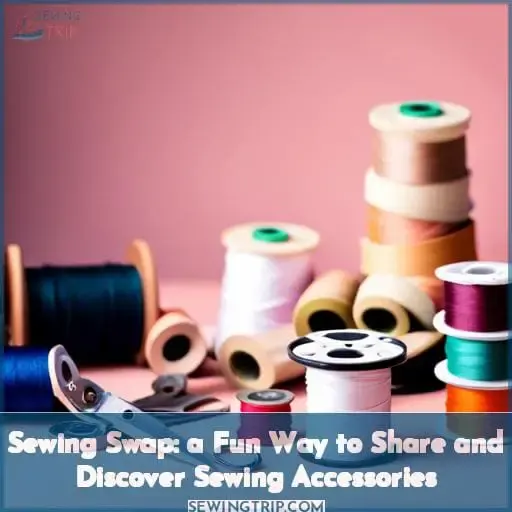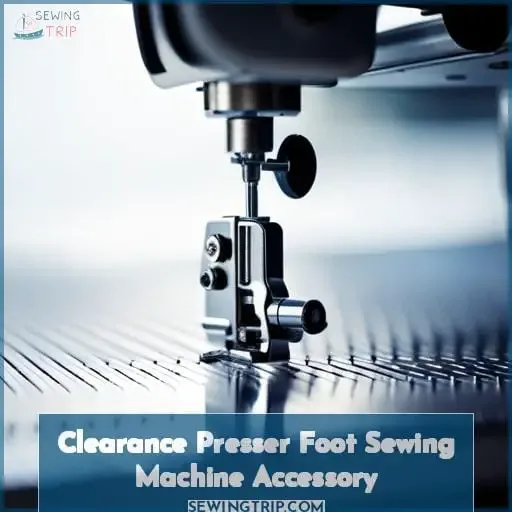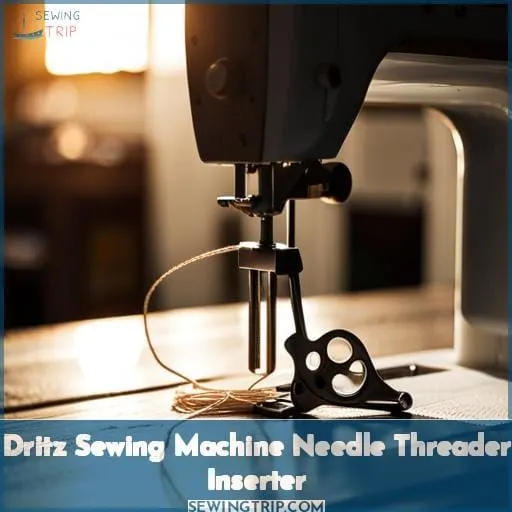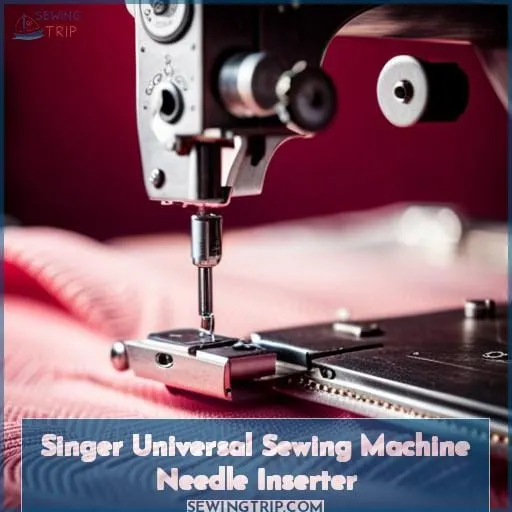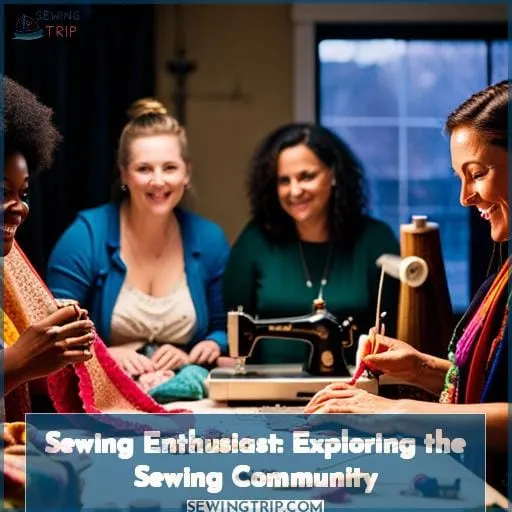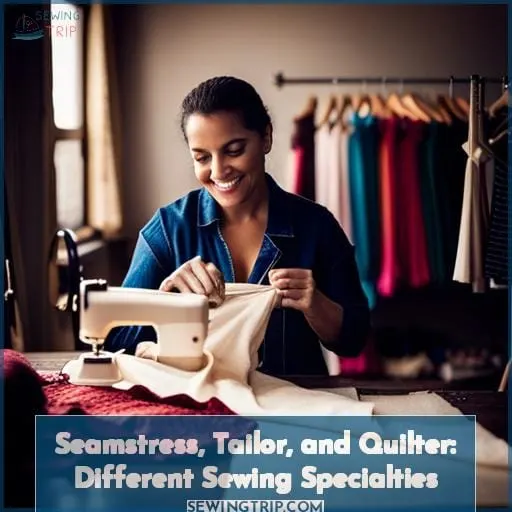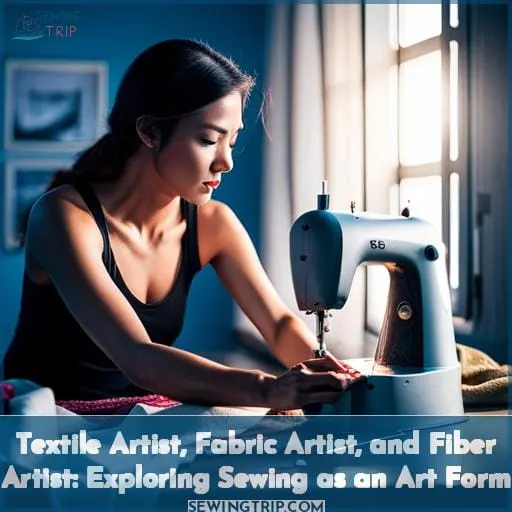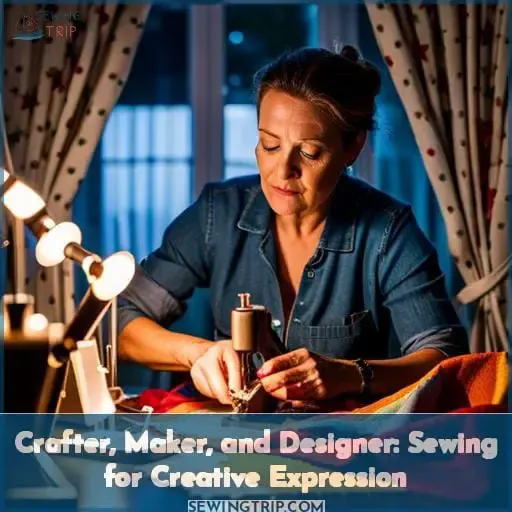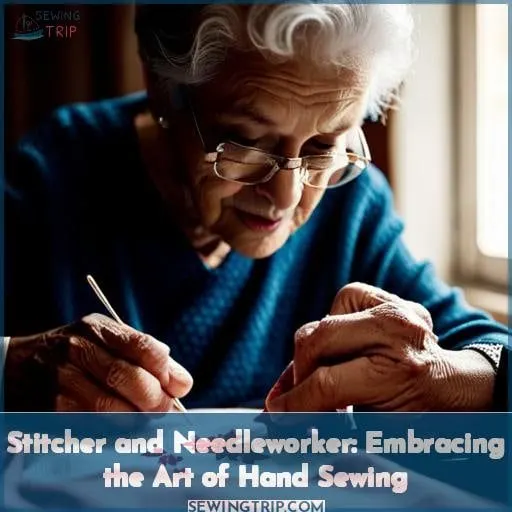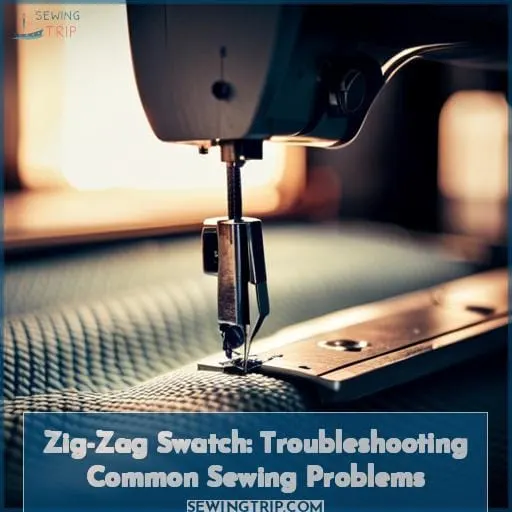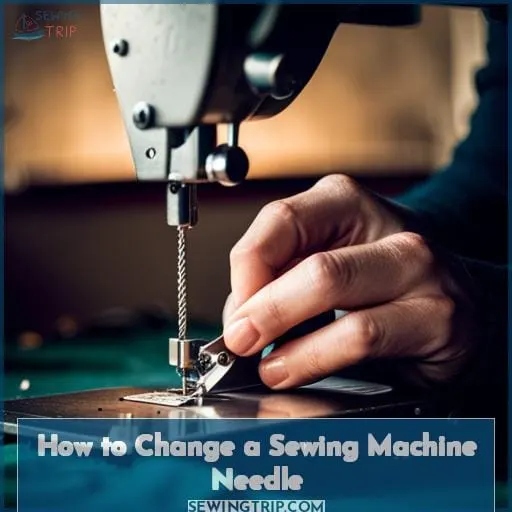This site is supported by our readers. We may earn a commission, at no cost to you, if you purchase through links.
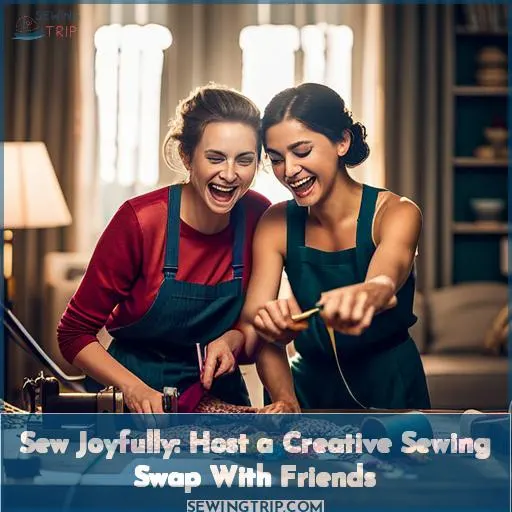 Sewing’s a stitch! If a creative sewing swap with friends sounds like your cup of tea, you’re in the right place. A swap allows you to share and discover new sewing accessories while connecting with fellow stitchers.
Sewing’s a stitch! If a creative sewing swap with friends sounds like your cup of tea, you’re in the right place. A swap allows you to share and discover new sewing accessories while connecting with fellow stitchers.
Clear out your sewing stash of machine feet and tools you don’t use. Trade them with friends for ones you’ve been eyeing or been meaning to try.
Swapping’s a fun way to expand your accessories on a budget and bond over a shared passion. Let’s dive in – you’ll learn how swaps work, essential tools to swap, and tips for sewing success. This comprehensive guide will empower you to confidently host a swap and troubleshoot problems.
Table Of Contents
- Key Takeaways
- Sewing Swap: a Fun Way to Share and Discover Sewing Accessories
- Clearance Presser Foot Sewing Machine Accessory
- Dritz Sewing Machine Needle Threader Inserter
- Singer Universal Sewing Machine Needle Inserter
- Sewing Enthusiast: Exploring the Sewing Community
- Seamstress, Tailor, and Quilter: Different Sewing Specialties
- Textile Artist, Fabric Artist, and Fiber Artist: Exploring Sewing as an Art Form
- Crafter, Maker, and Designer: Sewing for Creative Expression
- Stitcher and Needleworker: Embracing the Art of Hand Sewing
- Zig-Zag Swatch: Troubleshooting Common Sewing Problems
- How to Change a Sewing Machine Needle
- Frequently Asked Questions (FAQs)
- Conclusion
Key Takeaways
- Sewing swap allows sharing accessories, connecting enthusiasts.
- Trade machine feet, tools, patterns to expand collection.
- Meetups build community, tackle challenges together.
- Specialty needles, thread conditioners, fabric clips are popular swap items.
Sewing Swap: a Fun Way to Share and Discover Sewing Accessories
You’d love swapping sewing gadgets with fellow stitchers – it’s a blast to share and score new gizmos to simplify seaming and save scads of time!
Swapping sewing accessories like specialty needles, thread conditioners, and fabric clips with other enthusiasts opens up creative expression. You’ll find handy tools to inspire new projects while sharing your own troubleshooting tips and needle maintenance tricks.
Connecting over a common passion helps build community and tackles fabric conditioning challenges. With each meetup, you’ll uncover fresh techniques and stitch-savvy ideas from kindred spirits.
Exchanging sewing gadgets and gaining new skills enlivens this inspiring hobby. Stay open and keep swapping – who knows what sewing secrets or time-saving tools you’ll discover next!
Clearance Presser Foot Sewing Machine Accessory
This handy clearance plate helps facilitate smooth sewing for just $9.99, compatible with most Viking models since 2017. As a fellow sewing enthusiast, I know the frustration of dealing with tricky fabrics and bulky seams.
That’s why this clearance accessory is such a useful find! Simply place it between your fabric and presser foot when sewing on buttons or heavy seams, and voila – no more snags or uneven stitching.
For less than $10, it’s an easy way to expand your sewing machine‘s capabilities. Whether you’re working with silks or canvas, this little metal plate has you covered. Don’t let problem spots slow down your next project. With the right tools, like this clearance plate, you can handle any fabric or technique your patterns throw at you.
Dritz Sewing Machine Needle Threader Inserter
Gosh, that wee tool’ll thread your needle with a quick slip ‘n’ slide!
- It loops around the needle securely to hold it steady.
- Then the thin metal pin slides right through the eye.
- Allowing easy front-to-back threading of even small eyes.
- Much quicker than manual threading or eye straining.
This handy Dritz needle threader reduces frustration when changing needles. The spring-loaded metal construction firmly grasps needles for effortless insertion into the machine. With practice, you’ll be swapping out needles and threads in seconds. Needle inserters prevent finger injuries and make sewists smile! Simply depress to open, pop in the needle, and release to grip.
Fits most domestic machine needles. An affordable essential to add precision and ease to your sewing room.
Singer Universal Sewing Machine Needle Inserter
Well friend, that handy Singer needle inserter’ll make changin’ needles a cinch for ya! No more pokin’ your fingers tryin’ to get the needle seated just right.
I use mine all the time when I’m workin’ on my needlepoint patterns or testin’ out new thread techniques. It sure takes the frustration out of adjustin’ your zig-zag width and tension. And if you’re ever havin’ trouble with your serger, the first thing to check is if you’ve got the right needle installed.
Swappin’ needles with your sewing circle is so much simpler when you’ve got this tool around. Whether you’re workin’ with delicate silks or heavy denim fabrics, there ain’t nothin’ more important than havin’ the proper needle.
Sewing Enthusiast: Exploring the Sewing Community
As a fellow sewing enthusiast, immersing yourself within the sewing community connects you to a creative, skill-building hobby full of possibilities. Surround yourself with kindred spirits who share your passion. Learn sew-on badge making and fabric dye techniques from experienced sewists eager to pass on their knowledge through online tutorials.
Bond over sewing machine oil hacks that keep your machine running smoothly. Find inspiration by flipping through sewing magazines or perusing fabric artist Instagram accounts filled with beautiful handmade creations.
Support small fabric shops and fellow sewists by purchasing hand sewing starter kits or following sewing patterns from independent designers.
Within this encouraging, creative community, you can hone your skills, make lasting connections, and bring your unique fiber art visions to life through sewing.
Seamstress, Tailor, and Quilter: Different Sewing Specialties
You’re discovering the joys of sewing as a seamstress, while a tailor masters suit construction, and a quilter stitches memories.
- The sore fingers from learning hand-sewing techniques.
- The frustration of tangled thread and skipped stitches.
- The satisfaction of finishing your first project.
As a beginner, focus on learning the basics – from thread tension to fabric choice to sewing straight lines. Seek out an experienced mentor, accessory swaps, and sewing groups for support. Most importantly, let the creativity and sense of community inspire you.
With practice, you’ll gain skills and make new friends. Just take it one stitch at a time.
Textile Artist, Fabric Artist, and Fiber Artist: Exploring Sewing as an Art Form
Let’s explore more creative ways to work with textiles as fiber artists! As you tighten the screw and align the pins on the flat side, consider how the length of your fabric can bring dimension and exploration to your art.
Use embellishment techniques like stitching, appliqué, and mixed media integration to enrich the material.
Fiber art allows for freeform expression through painting, printing, and sculpture with textiles. Don’t just make quilts and clothing – bring out your inner artist through your textile creations.
Experiment with different materials and find new ways to communicate ideas. The only limit is your imagination!
Crafter, Maker, and Designer: Sewing for Creative Expression
Crafter, whip up your own chic threads on a modern-day loom to channel your inner Betsy Ross. Let your creative spirit soar as you browse bolts of fabric, caressing cottons, taffetas, and tweeds, indulging in possibilities.
Select vibrant solids or intricately woven prints to reflect your vision, then study sewing patterns with glee as puzzle pieces to actualize your design. Maintain your trusty sewing steed, cleaning gunky gears so stitches sing smooth.
When learning new techniques, embrace mistakes; imperfections imbue soul. But most of all, enjoy the process. Each piece crafted infuses heritage and meaning no fast fashion could replicate.
Sewing connects us to ancestors who once hand-stitched hopes into flour sacks. So thread on through frustration and triumph alike to craft wearable art echoing your distinctive essence.
Stitcher and Needleworker: Embracing the Art of Hand Sewing
Embracing the art of hand sewing opens up a world of vintage treasures. As you get lost in stitching patterns on linen, let your imagination run free with thread color selection and fabric choices. Try different needlepoint techniques on that heirloom doily found at the thrift store.
Keep your stitches loose like the women who stitched before you. Clearing plates can help adjust stitch tension problems on manual sewing machines. With each hand stitch you make, you leave an imprint of your creative spirit. The possibilities are endless when you embrace the intimacy of needle and thread.
Zig-Zag Swatch: Troubleshooting Common Sewing Problems
Frustrated with loose stitches, puckered fabric, and deformed seams? Don’t let top thread breaks kill your sewing joy – with a critical eye and a few key tips, you’ll have the know-how to troubleshoot and achieve sewing success.
Loose Stitches
You’re pulling the thread too tightly. Crinkled thread indicates tension issues. Check your machine’s settings and rethread carefully. A damaged bobbin or bent needle can also cause loose stitches. Make sure your needle is straight and your bobbin case is smooth.
Snapped thread and tangled fabric point to other problems. Slow down and guide the fabric gently to prevent this. With patience and practice, your stitches will neaten up in no time. Sewing takes finesse, but the rewards are well worth it.
Puckered Fabric
If the fabric is puckering as you sew, it could be that the tension is too tight. Try loosening the top thread tension slightly until the fabric feeds smoothly. Uneven feed rate between the top and bottom threads may cause fabric to gather under the pressure foot.
Test different tension settings on a jersey tension swatch. Ensure the grainline is properly aligned and the fabric isn’t stretching or distorting as you sew. Elastic fabrics like knits can stretch when sewn, so support them with an elastic cord when sewing seams.
Deformed Stitches
Broken stitches can really test your patience, friend, but don’t lose your thread! Check your machine’s tension and the condition of the needle before you start sewing up a storm again.
- Examine the threading path for snarls.
- Inspect the bobbin area for stray fibers.
- Adjust the tension dial if needed.
With some troubleshooting, you’ll be stitching perfectly again in no time.
Top Thread Breaking
Your top thread’s snapping from tension problems, so double-check your machine’s threaded right and the tension dial’s adjusted. Seam fraying and fabric pilling happen with poor tension. Bobbin winding’s tricky; be patient.
Automatic threading seems easy but can jam on buttonholes. Take your time, and you’ll get it humming.
Troubleshooting Tips for Sewing Success
You’d surely have more humming hags with handy haberdashery if you hosted a stitch ‘n bitch to troubleshoot sewing snafus, girlfriend!
- Check thread tension
- Clean lint from bobbin area
- Change needle size or type
- Use quality thread
- Ensure correct presser foot
Sew on, sisters! Grab some rosé and let’s get stitching. With the right tools, techniques, and TLC, we’ll have your machine singing again in no time.
How to Change a Sewing Machine Needle
With dozens of exciting fabrics calling your name, it’s no wonder you’re eager to try that new needle and thread combination. Start by firmly pulling the old needle straight up and out, insert your shiny new needle fully until it stops, slowly turn the handwheel to check positioning, then get sewing and remember to change needles often for the best stitch quality and to prevent breaks.
Removing the Old Needle
Before removing the old needle, examine it closely to make sure it’s not bent or damaged. A damaged needle could be the culprit behind skipped stitches or snagged threads. Gently grasp the needle, unscrewing it counterclockwise. Pull it straight up and out of the sewing machine, storing it safely away from your work area.
When ready, promptly replace the needle, taking care to insert it properly according to your machine’s manual. Double-check that it’s secure before beginning your next project. A fresh needle makes all the difference for smooth sewing.
Inserting the New Needle
Simply slide the needle up into the clamp until it hits the stopper using the handy Singer needle inserter.
- Grip firmly and guide the needle straight up into place.
- Push until the needle stopper prevents further motion.
- Release the inserter to lock the needle securely.
- Test the needle by gently tugging to ensure proper installation.
Setting Up for Sewing After Needle Change
After carefully rethreading the upper tension, double-check that the newly inserted needle is centered and secured before gently testing it on a scrap piece.
With the needle now changed, take a moment to set the needle depth and lower the presser foot.
Make sure all threads are tucked back and out of the way before slowly starting to sew.
Test a few stitches and observe the stitch length, adjusting the tension as needed.
The scrap fabric allows you to check tension and stitch appearance before moving onto your actual project fabric.
With a few thoughtful adjustments, your machine will be ready to reliably sew with the new needle.
Final Notes for Needle Maintenance and Safety
You’ll sustain quality stitches by routinely inspecting needles and promptly replacing any that are bent, blunt, or damaged.
- Store needles properly in cases to prevent bending.
- Adjust machine settings like tension when changing needle sizes.
- Follow safety precautions like unplugging the machine before making changes.
- Use the right needle size for your thread and project.
Proper needle care safeguards your machine and sewing results.
Frequently Asked Questions (FAQs)
What are some tips for organizing a successful sewing swap event? This could cover planning, advertising, venue ideas, suggested swap item categories, etc.
Start sourcing sellers and sharing spaces to swap stashing supplies. Advertise alluringly. Vet venues vibrantly. Categorize creatively – consider cute clothes, rad remnants, plush patterns, perfect purse panels.
Where can I find sewing swap groups or events in my local area? This relates to finding both in-person and online swapping communities.
You can find local sewing swap groups on Meetup, Facebook, and Craigslist. Check sewing stores for bulletin boards too. Online, connect through swapping subreddits and niche forums. Just search sewing swap plus your city or interest.
What should I look for when buying a used sewing machine or serger? This covers evaluating condition, testing functions, price negotiation, manuals, accessories, etc.
Look for good condition and fully functioning parts. Test all stitches and buttons. Request manuals and accessories. Negotiate a fair price based on age and wear. Quality machines can last for decades if well-maintained.
How can I connect with other sewing enthusiasts online? Tips for finding sewing friends through social media groups, forums, blogs, pattern communities, etc.
You could join sewing groups on Facebook or Reddit to connect with fellow enthusiasts. Interact regularly by commenting on posts, sharing your projects, and messaging members. Check if there’s a local sewing circle or meetup in your area too. Getting involved in the sewing community online is a fun way to make friends, get inspiration, and share your passion.
What supplies or tools do I need to get started sewing? Covers sewing machine recommendations, fabric and notion essentials, starter project ideas, beginner sewing books/classes, etc. for someone just starting out.
Starting sewing is easy with a basic machine, fabric, thread, needles, pins, and scissors. Choose simple patterns like bags or pillows to begin. Take a class so an experienced sewer can show you sewing techniques hands-on.
Practice often to build skills. Join an in-person or online group to connect with supportive sewing friends. YouTube has many free tutorials. Have patience and enjoy the creative process! Sewing opens up a world of possibilities.
Conclusion
Experience the joy of sewing with friends by hosting a creative swap! Gather your sewing circle and exchange accessories, fabrics, patterns, and ideas. Learn new techniques, troubleshoot issues, and share your passion. With an open heart and curious mind, your sewing will flourish.
Let this circle of creatives kindle your inspiration and skill. Joyfully embrace both sewing’s frustrations and rewards—for the experience of creating together is the richest fabric of all.

